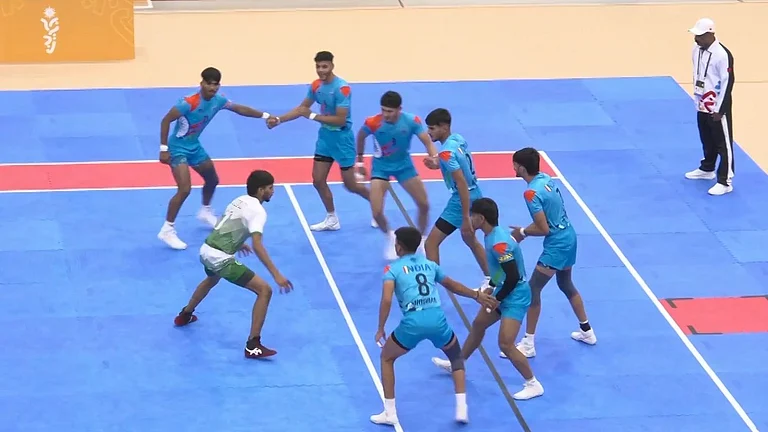Punjab-Rajasthan-Gujarat Border
At Kelnor, a tiny outpost on the Rajasthan border, armed bsf jawans on camel-back patrol the zero line, dawn and dusk. A few feet behind the sturdy border fence, strung out at one-km intervals, jawans crouch on makeshift observation posts (OPs), binoculars trained ceaselessly on Pakistan.
For six months, they have been observing heightened activity on the Pakistani side of the fence. Since late May, they have been aware of the mobilisation by the Pakistani armed forces, stationed 10 km behind the forward outposts. From Tuesday last week, the bsf jawans"the nation's first line of defence against enemy aggression"have been on high alert, with intelligence reports indicating massing of Pakistani troops at the border.
Reflexively, the Indian armed forces in the western sector have been mobilising since late May. From Gurdaspur (Punjab) in the north to Sir Creek (Gujarat) in the south, the army and air force sit anything from 500 metres to 10 km of the border, ready for action. Tanks, armoured cars, signals trucks, air defence radars and heavy-duty weaponry, shrouded in camouflage nets and foliage or hidden in groves and brush, are scattered cross-country along the 2,000-km stretch of the border. Concrete bunkers, some new, some dating back to '71, are now fully manned. Schools, government buildings, even private homes, in border towns and villages house soldiers.
From north to south, the topography changes drastically, the lush green fields of Punjab melding into the dessicated sandscape of Rajasthan, which fades into the superheated saltpans of the Rann of Kutch, marking Gujarat's border with Pakistan. Artificial defensive barriers are the strongest in Punjab, always a vulnerable point for India, while in Rajasthan and Gujarat, the desert and the Rann are in themselves a natural defence.
Running along a substantial part of the 523-km Punjab border is the dcb (ditch-cum-bund), known in local parlance as the 'defence ' . For the villages precariously stationed between the dcb and the border fence, it is a great psychological boost. In the event of cross-border aggression, the villagers say, they have only to retire behind the 'defence ' for safety. The fence itself, floodlit at night, is no barrier to armoured vehicles but could delay them by a vital minute or two in an offensive.
Running near-parallel to the IB (international border), the dcb is an effective anti-tank barrier, tough to breach. To cross the deep water-filled ditch, the enemy will have to deploy bridge-laying tanks. The high bund bordering the ditch is riddled with fully-manned bunkers and behind, anti-tank weaponry is ready and waiting.
Several km behind is the secondary dcb, with identical bunkers. Between the two are a series of scattered underground bunkers, barely visible even from ground level, completely invisible from air. At the moment, unseasonal rains have created another natural barrier by flooding the already water-logged paddy fields running alongside the IB. 'It's not campaign season. Armoured vehicles would find it a bit tough to negotiate fields where even men sink knee-deep into slush, ' said one of the 'men-in-black ' (armoured corps).
Deployment is greater in the Khemkaran and Hussainwala sectors, south of Wagah, where the Pakistani army penetrated in '65, grabbing a big chunk of Ferozepur. It was only by destroying the bridge across the Sutlej and flooding the area that their advance was halted. In Khemkaran lies the famous Sehjra bulge, a bulb-shaped portion of Pakistan thrusting into Indian territory. Heavily fortified on both sides, it's bound to be one of the hottest trouble-spots in Punjab during a conflict. Intense Pakistani troop movement was observed here on May 28/29 and June 10/11. On June 17, radio intercepts by military intelligence indicated a possible attack here at 3.30 a.m. It didn't materialise.
Well-connected by road and rail, Khemkaran is strategically located. The Pakistani Sehjra observation tower, manned round the clock, looks directly into the town. Peering through binoculars from a bsf OP, one is eyeball-to-eyeball with the Pakistani Rangers atop the tower. On the opposing side, at varying distances from zero line, is the Pakistani dcb, shrouded in four layers of kikar trees. Through a gap in the dcb, movement of Pakistani army convoys is clearly visible.
Pakistani villages along the border"Mabokke, Bukhiwal, Shaikupura, Fattiwal, Amoke, Nagar Amin"have been vacated, leaving only a skeleton population. A similar situation prevails on the Indian side. Women, children, cattle and valuables have been moved to locations well behind the forward dcb, deposited with relatives and friends. 'The evacuation has been entirely voluntary, conducted without any panic or haste, in an orderly fashion, ' said SP (Operations) Anita Sinha.
While the entire stretch of the Punjab border has been affected, Khemkaran is the worst hit. Memories of Pakistani occupation in '65 are still vivid. In most villages, the menfolk, particularly senior citizens, have stayed behind to attend to the fields. Says farmer Mann Singh of Rattoke: 'We all have to do our jobs, even during war. Somebody has to feed the soldiers ' . The troops have been made more than welcome by the villagers, who house and feed them.
During the day, the villagers and labourers cross the border fence to work in fields adjoining the zero line, often greeting their counterparts in Pakistani fields a few feet away. A dirt track marks the zero line"the high road is India's, the low road Pakistan's. bsf jawans protect them as they work. During the night, they retire behind the 'defence ' to sleep.
South of Husssainwala, Sri Ganganagar"where a canal on the opposing side gives Pakistan a natural defense"is the only green stretch on the 1,037-km Rajasthan border. The rest is scorching desert. For months, there has been mixed deployment of Pakistani Rangers and army personnel at the border, with the latter conducting recces in civvies or Ranger uniforms. On the surface, normalcy prevails, with daily meetings between the Pakistani Rangers and the bsf. There is joint patrolling and superficial camaraderie.
Around 150 west of Barmer lies the Kelnor border outpost. On the Pakistan side of the fence, a three-tiered observation post sits on a high ridge. A Ranger, binoculars trained on the road leading to the bsf's Kelnor border outpost, stands on top. 'He can see traffic approaching for five kms. It's a highly strategic tower,' explains a senior officer. Similar towers have been coming up all along the Rajasthan border for six months.
'Kargil was clearly planned well in advance. We have seen self-contained three-tiered bunkers-cum-observation posts and other fortifications being rapidly built on the Pakistani side for several months, ' said IG, bsf Bakhshish Singh. The bsf, which set up zero-line posts only after the border was fenced in '95, is setting up its observation towers at the IB only now. Earlier, the towers were located 1.5 km or more east of the border.
Across the border in Pakistan, villages like Jarilo, Baori and Mujahid have been evacuated. But on the Indian side, many families that had moved away in the initial panic have returned. 'Why stay in another's house?' said Chattar Singh of Kalron ka Tala, who returned from interior Chottan a fortnight ago. On the Jaisalmer side, some villages"Sundara, Rohri, Pachhra"continue to be deserted. 'The bsf says it'll warn us in time, but you can't trust them. The last two times, they didn't tell us and we lost everything"in '65, the Pakistanis overran us and in '71, the Indian army did the same, ' says Shankar, a local.
Many border residents crossed over to India only in '71. 'I'm from Jarilo in Pakistan (part of the erstwhile Hindu kingdom of Umarkot), ' said Har Lal. 'I still have relatives there, though I have not seen them for years. ' In '71, the Indian army reached Nayachor. When it withdrew, the Hindu villagers"like Chhattar Singh who lived in Chahcro in Pakistan"came with it.
Many border residents are expert smugglers; seizures of quintals of silver and gold from their homes weren't uncommon. 'We've information on saboteurs and informers among them, but the police rarely acts on it, ' said a senior bsf official in Jodhpur. In Pakistan, the past year has seen a special drive in border areas to pick up informers.
In the first three weeks of June, a constant stream of troops and armoured vehicles have been moving by rail from the Sailwas and Banad stations near Jodhpur to various points along the Rajasthan border. So far, the armed forces are 6 to 10 km behind the IB, but can be deployed within minutes in the event of an attack. Trials of the T-90 tanks have been under way at Rathi near Jaisalmer since May. At the air force bases in Jodhpur and Utarlai, exercises are being conducted "within a couple of minutes, the heavily camouflaged fighters can take off and engage.
In Gujarat, most of the 508-km long border comprises the Rann of Kutch. Flatland without a hint of vegetation, it turns into swamp at the slightest hint of moisture and allows no sudden intrusions. In '71, Indian troops took the high ground ahead of the Rann but lost it in arbitration. Sir Creek, south of the Rann, a 99-km long stretch of disputed territory, is an entry point for infiltrators. On June 1, 6 isi agents with arms, ammunition, explosives and fake currency were caught there. A recent cyclone did considerable damage to bsf installations that have been repaired on a war footing. The water wing of the bsf which polices Sir Creek up to midstream, has stepped up vigilance and deployed floating OPs.
The morale of the troops and the civilians at the border is high. In Jodhpur, 40,000 applicants turned up to enlist in the first week of June. Ex-armed forces and paramilitary veterans have turned up in droves to offer their services. Says 80-year-old Nain Kanwar of Hurron Ka Tala village on the Rajasthan border, a veteran of two wars: 'We are not going to run away. But tell them not to fight. Tell them to keep peace so that we don't lose our homes.'


























